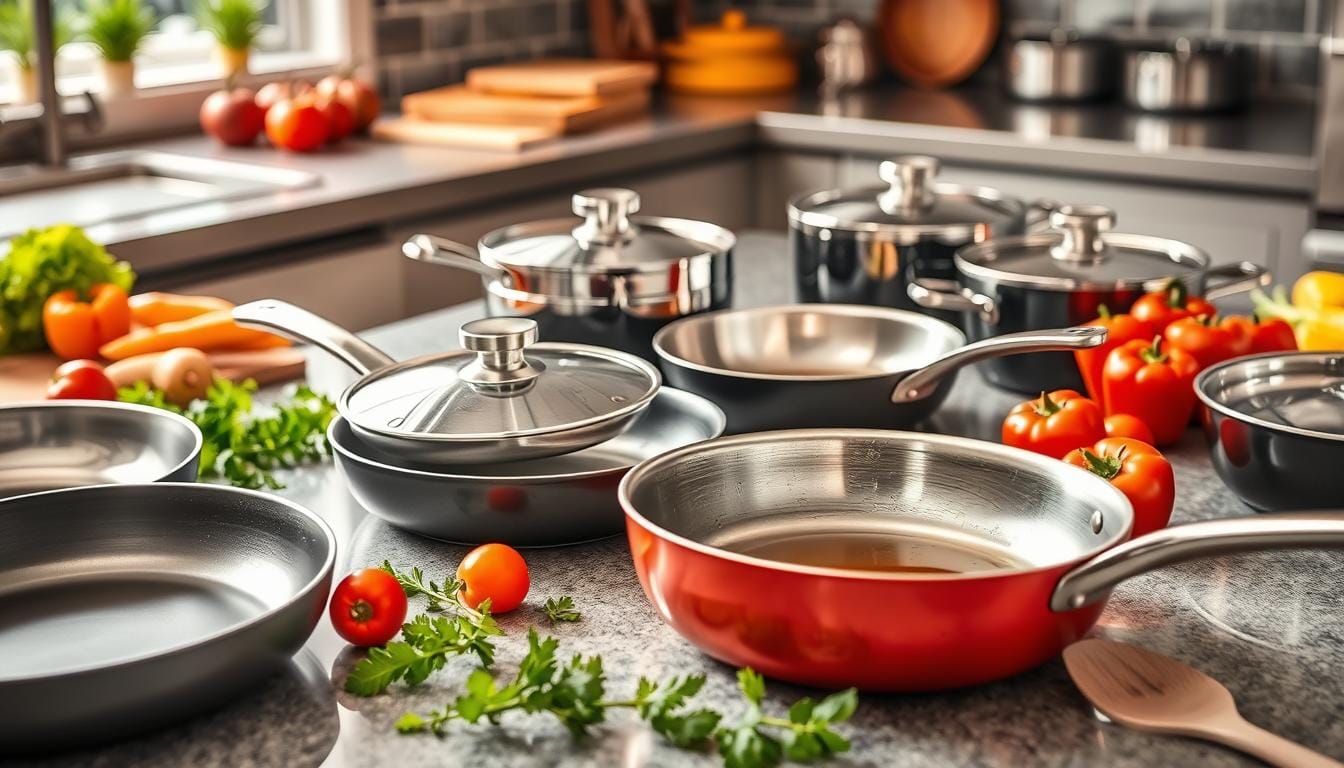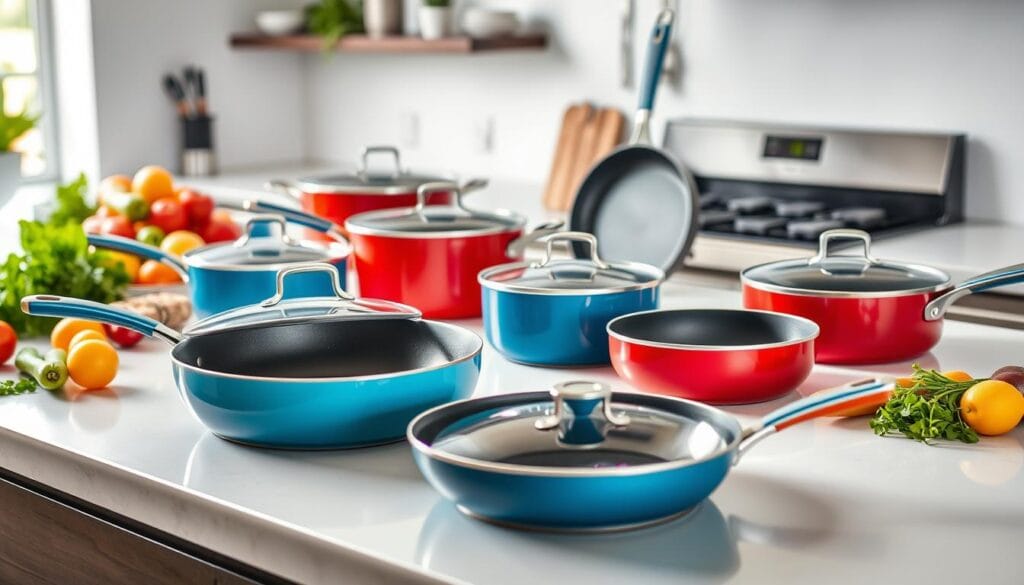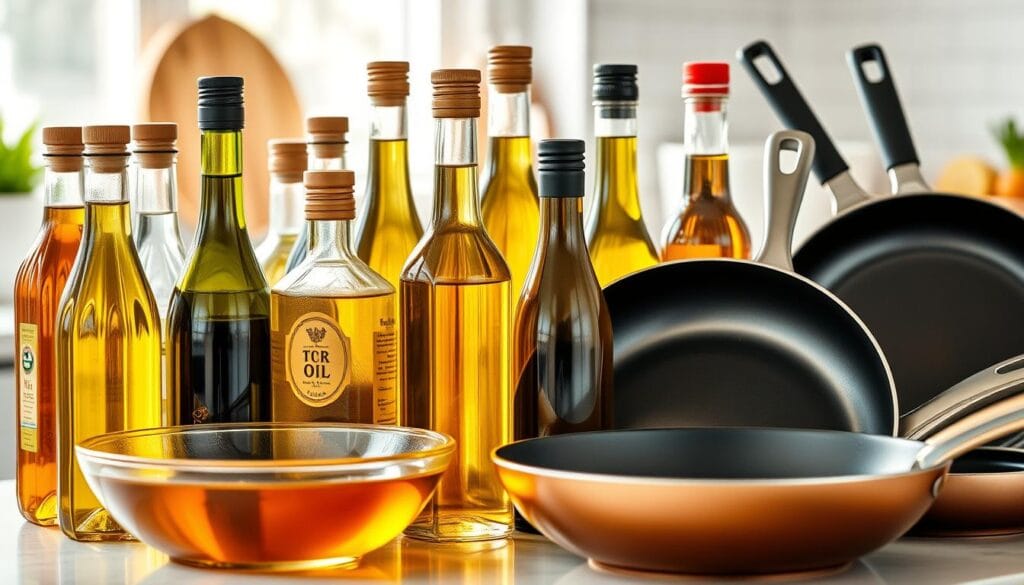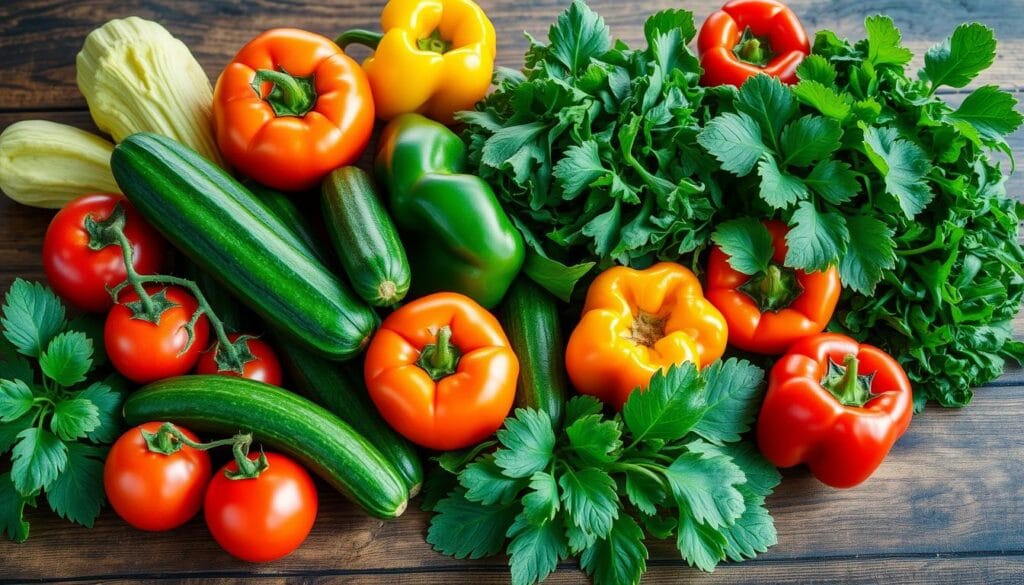Ever had food stick to your cookware, making it hard to clean and ruining your dish? I’ve been there too. As a home cook, I found how to prevent food from sticking is all about a few simple tricks and the right cookware. In this guide, I’ll share how to get your kitchen to non-stick perfection, so you can enjoy making delicious meals.
Whether you’re cooking a steak, stir-frying veggies, or making a frittata, knowing why food sticks is key. We’ll look at how preheating pans and using the right oils and fats help. Let’s dive in and become kitchen wizards together!
Understanding Why Food Sticks
Ever had trouble with food sticking to your pots and pans? It’s not just about not cleaning well. It’s about the science behind it. Food sticking often comes from bad temperature control, not enough oil, or the wrong cookware.
Common Ingredients That Often Stick: How to Prevent Food From Sticking
Some foods stick more than others. Proteins like fish, eggs, and cheese are big culprits. Their molecules bond strongly with cookware, making them hard to get off.
The Role of Temperature in Cooking: How to Prevent Food From Sticking
Temperature is key to avoiding sticking. Too little heat lets moisture build up, causing food to stick. Too much heat burns food, making it stick even more. Keeping the right temperature is crucial for a non-stick cooking experience.
How Different Cookware Affects Sticking
The cookware you use affects sticking a lot. Non-stick pans are made to prevent sticking. But stainless steel and cast iron can stick if not seasoned or cared for.
Heating pans until they smoke helps. It makes a non-stick surface by removing moisture and letting oils bond with the metal. This “patina” helps prevent sticking, even with traditional materials.
“Understanding the science behind why food sticks can help you develop strategies to prevent this common kitchen frustration.”
By knowing about ingredients, temperature, and cookware, you can make sure food slides off easily. This lets you enjoy cooking more, without the stress of stuck-on food.
Choosing the Right Cookware Materials
The type of cookware you pick is key to preventing food from sticking. Non-stick, stainless steel, and cast iron each have their own benefits. Knowing what each offers can help you choose the best for your kitchen.
Non-stick vs. Stainless Steel vs. Cast Iron: How to Prevent Food From Sticking
Non-stick pans are great for easy food release, which is why many prefer them. But, they need gentle care to keep the coating intact. Stainless steel pans are durable and can get non-stick with seasoning and heat. Cast iron pans also get better with use and care, becoming more non-stick.
Advantages of Ceramic Coated Cookware: How to Prevent Food From Sticking
Ceramic-coated pans offer a non-stick option that’s safe and lasts long. They heat evenly and are easy to clean. They’re a good choice because they don’t have harmful chemicals like PTFE.
Whether you pick non-stick, stainless steel, cast iron, or ceramic, proper care is essential. Seasoning, preheating, and maintenance are crucial for non-stick performance. By understanding each material’s strengths, you can choose the best for your cooking needs.
Preparing Cookware Before Cooking
Getting your cookware ready is key to avoiding stuck food. A major step is seasoning cast iron pans. This means applying a thin layer of oil and heating it. This creates a non-stick surface by sealing the cast iron’s pores.
Another vital technique is preheating your pans before cooking. This is especially important for carbon steel woks or cast iron skillets. But, don’t preheat non-stick pans. Heat the pan until it smokes or water droplets dance on it. This step removes moisture and helps oils stick to the metal, making cooking smoother.
“Proper preparation of your cookware is the foundation for preventing food from sticking.”
By seasoning and preheating your pans, you’re ready for cooking success. These simple steps greatly improve your kitchen experience.
Using the Right Cooking Techniques: How to Prevent Food From Sticking
Proper cooking techniques are key to preventing food from sticking to your cookware. When sautéing, it’s crucial to ensure your pan is hot and well-oiled before adding your ingredients. Using enough cooking oils and fats creates a barrier between the food and the pan, allowing for effortless cooking.
How to Sauté Without Sticking: How to Prevent Food From Sticking
To sauté without sticking, wait until your pan is preheated to the proper temperature control. Once hot, add a generous amount of oil or fat, swirling the pan to coat the surface evenly. Carefully place your ingredients in the pan, making sure they don’t overcrowd. Allow proteins, such as chicken or steak, to develop a nice crust before attempting to flip them.
The Benefits of Using Enough Oil: How to Prevent Food From Sticking
- Oils with high smoke points, like canola, vegetable, or peanut oil, are excellent for preventing sticking.
- Wait until the oil becomes glossy and shimmers, indicating it has reached the optimal temperature.
- Adjust the heat level as needed during cooking to avoid burning or sticking.
- Use specific techniques, such as waiting for a good crust to form, when flipping delicate items like fish or pancakes.
By mastering these cooking techniques and utilizing the right cooking oils and fats with proper temperature control, you’ll be able to sauté, grill, and pan-fry your favorite dishes without the frustration of sticking food.
Selecting Proper Ingredients: How to Prevent Food From Sticking
Choosing the right ingredients is key to preventing food from sticking. Fresh, high-quality produce is essential for great cooking. Always check your produce for any signs of spoilage or too much moisture.
Pat dry any fresh ingredients, especially meat or fish, before cooking. This helps prevent sticking.
Moisture is a big problem when it comes to sticking. Too much moisture can stop food from browning properly. This makes it more likely to stick to the pan.
To avoid sticking, pay attention to your ingredients’ moisture levels. Remove any excess moisture before cooking.
How to Choose Fresh Produce Wisely: How to Prevent Food From Sticking
- Look for fresh produce with vibrant colors, firm textures, and no bruises or blemishes.
- Don’t overcrowd the pan. This can lower the temperature and cause steaming instead of searing.
- Let ingredients come to room temperature before cooking. Cold items stick more easily.
The Impact of Moisture on Sticking Ingredients
Too much moisture can cause sticking. Wet ingredients don’t sear or brown well. To prevent sticking, pat your ingredients dry before cooking.
This creates a barrier between the food and the pan. It helps prevent sticking.
“Mastering the art of ingredient selection and preparation is crucial for preventing food from sticking and achieving consistently delicious results in the kitchen.”
| Ingredient | Moisture Content | Recommended Preparation |
|---|---|---|
| Chicken Breasts | Moderate | Pat dry with paper towels before cooking |
| Salmon Fillets | High | Blot gently with paper towels to remove excess moisture |
| Zucchini Slices | High | Gently squeeze or pat dry before cooking |
Utilizing Cooking Sprays and Oils
Choosing the right cooking oils and sprays is key to preventing food from sticking. Cooking oils and fats are essential for non-stick cooking. Knowing which ones to use can greatly improve your cooking skills.
Best Types of Oils for Non-Stick Cooking
For cooking at high heat, oils with a high smoke point are best. Avocado oil and canola oil are great choices. They can handle high temperatures without burning or smoking.
When you apply these oils to a hot pan, they make a slick surface. This allows food to slide off easily.
When to Use Cooking Sprays Effectively
- Cooking sprays are handy for creating a light, even coating on pans and bakeware.
- But, use them sparingly to avoid damaging non-stick cookware.
- There are now diet-friendly, non-GMO, gluten-free, and paleo-friendly cooking sprays available.
- Cooking spray is versatile. It can be used to grease pans, keep parchment paper in place, and more.
To get the most out of cooking oils and fats, apply them to a preheated pan. For grilling, use long tongs to apply oil to hot grates. This creates a non-stick surface for your food.
| Cooking Spray | Butter | Olive Oil |
|---|---|---|
| 7 calories, 1g fat per 1-second spray | 100+ calories, 12g fat per 1 tbsp | 120 calories, 14g fat per 1 tbsp |
“Cooking spray coats pans more evenly than butter or shortening, ensuring baked goods won’t stick, especially in pans with crevices.”
Mastering Temperature Control
Proper temperature control is key to avoiding food sticking to your cookware. Understanding heat management can improve your cooking skills. This ensures your dishes are perfect every time.
Recognizing When to Lower the Heat
Start with high heat to sear meat or vegetables for a nice crust. But, if food starts sticking or browning too fast, lower the heat. Cooking most foods between 350°F and 400°F prevents sticking and ensures even cooking.
The Dangers of Cooking at Too High Temperatures
Cooking at too high temperatures can cause problems. The oil or fat in your pan may break down, making it sticky. High heat can also burn or dry out food, ruining its flavor and texture.
For delicate items like eggs or fish, use medium heat. This helps avoid sticking and ensures the best results.
To check the right temperature, watch for light smoke or dancing water droplets in your pan. Adjust the heat as needed to keep the ideal temperature for your dish.
“Mastering temperature control is the key to unlocking your full potential as a home cook. With a little practice, you’ll be able to create perfectly seared, non-stick dishes every time.”
| Temperature Range | Cooking Application |
|---|---|
| High Heat (400°F+) | Searing meat, caramelizing vegetables |
| Medium Heat (350°F-400°F) | Sautéing, frying, baking, roasting |
| Low Heat (below 350°F) | Simmering, poaching, reheating |
Remember, mastering proper temperature control is the key to preventing food from sticking and ensuring your dishes turn out perfectly every time.
Cleaning and Maintaining Your Cookware
It’s important to take good care of your cookware to make it last longer. Whether you use silicone utensils or non-stick cookware, a few simple steps can keep your kitchen tools in great shape.
Tips for Caring for Non-Stick Cookware
When using non-stick cookware, avoid metal utensils to prevent scratches. Use silicone or wooden tools instead. Clean your pans well after each use with a mild detergent and a soft sponge or cloth. Don’t scrub too hard, as it can damage the non-stick surface.
How to Avoid Scratching Your Cookware
To prevent scratches, be careful how you store and handle your cookware. Always place a protective layer, like a paper towel or soft cloth, between each piece. Stack your cookware with the heaviest items at the bottom to avoid scratches. Also, be careful with metal utensils, as they can scratch non-stick surfaces easily.
Regular maintenance is key to keeping your cookware in good shape. By following these tips, you can enjoy easy cooking and keep your kitchen tools looking new for years.
“With proper care, non-stick pans can last for years, making them a versatile and durable option for various cooking needs.”
Troubleshooting Sticking Issues
When food sticks to your cookware, don’t worry. You can fix it with a few tricks. First, let the food cook a bit longer. This usually helps it release once it’s properly seared or caramelized.
What to Do When Food Sticks
If food still sticks, try deglazing the pan. Use a little liquid like broth, lemon, or water. This method loosens stuck food, making cleaning easier. Also, don’t overcrowd the pan. This can cause too much moisture and sticking.
Learning from Mistakes in the Kitchen
Every time food sticks, it’s a chance to learn. Was the pan too cold? Or did you use too little oil? Maybe you put too much food in the pan, blocking searing.
By figuring out what went wrong, you can improve your cooking. Even pros sometimes struggle with sticking. So, see each mistake as a way to get better and enjoy cooking more.
FAQ
What are the key factors for preventing food from sticking?
To prevent food from sticking, use clean cookware. Also, make sure to lubricate it with cooking oil. And, the cooking surface should be hot before adding food.
How does temperature affect food sticking?
Temperature is key. If it’s too low, food sticks. But, if it’s too high, it burns. Preheat pans until they start to smoke to create a non-stick surface.
How do different cookware materials affect food sticking?
Non-stick pans are easy to use but need care to avoid damage. Stainless steel and cast iron pans get non-stick when seasoned and preheated. Cast iron gets better with use and care.
Ceramic-coated cookware is non-toxic and non-stick. It’s durable if used right.
How should you prepare cookware to prevent sticking?
Season cast iron by coating it with oil and heating it. Preheat pans before adding oil. Heat until the pan smokes or water dances on it. This works best with carbon steel woks and cast iron pans, not non-stick.
What cooking techniques help prevent sticking?
Make sure the pan is hot and well-oiled before sautéing. Use enough oil to prevent sticking. Let proteins develop a crust before flipping them.
For grilling, clean and oil the grates when hot. Don’t flip food too soon.
How do the quality and preparation of ingredients affect sticking?
Use fresh produce and pat dry ingredients before cooking. Excess moisture causes sticking. Avoid overcrowding the pan to prevent steaming.
Room temperature ingredients stick less than cold ones when added to a hot pan.
What types of oils and fats are best for non-stick cooking?
Use high smoke point oils like avocado or canola for high-heat cooking. Cooking sprays work but use them sparingly. Apply oil to a preheated pan for the best results.
How can you maintain the right temperature for preventing sticking?
Start with high heat for a sear, then lower it if needed. Avoid overheating to prevent sticking or burning. For delicate foods, use medium heat.
Use visual cues like light smoke or dancing water droplets to check if the pan is ready.
How should you care for your cookware to maintain its non-stick properties?
For non-stick pans, avoid metal utensils and use silicone or wooden tools instead. Clean thoroughly after each use but avoid harsh scrubbing. For cast iron and carbon steel, maintain seasoning by cleaning with hot water and re-oiling after use.
What should you do if food still sticks to the pan?
If meat sticks, let it cook longer. It often releases naturally when properly seared. For stubborn sticking, try deglazing the pan with liquid to loosen food particles.
Learn from mistakes by identifying the cause, like inadequate preheating, insufficient oil, or overcrowding.





